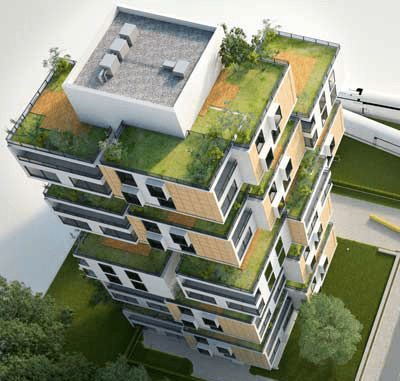Rajan Rawal
CEPT University, Ahmedabad, India
Yash Shukla
CEPT University, Ahmedabad, India
Subham Das
CEPT University, Ahmedabad, India
Corresponding Author: subham.das@cept.ac.in
Tej Chavda
CEPT University, Ahmedabad, India
Rahul Agnihotri
Cool Coalition at UN Environment Programme, Paris, France
Lily Riahi
Cool Coalition at UN Environment Programme, Paris, France
Benjamin Hickman
Cool Coalition at UN Environment Programme, Paris, France
Parimita Mohanty
Cool Coalition at UN Environment Programme, Paris, France
Cite this article
Highlights
- A systematic review of the Urban Heat Island Effect (UHIE) assessment literature and practices.
- Derivations and defining the Level of Detail (LoD) classification.
- Identifying the purposes of the UHIE study and categorizing the LoD for a ‘Fit for Purpose’.
- Developing a commonly agreed methodology for Indian Cities.
Abstract
The paper recognizes that the Urban Heat Island Effect (UHIE) occurs primarily due to urbanization impacting land surface characteristics, where the blue-green cover is replaced with complex-built fabric and increased anthropogenic heat emissions within urban areas. Without a common agreed-upon methodology with specific objectives that cities wish to accomplish, Indian cities are adopting varied methods to assess UHIE that do not help them attain the predefined objectives and are often found to be less scientific. This paper proposes a standardized methodology and underpins its argument on two frameworks, ‘Fit for the Purpose’ and ‘Level of Details,’ making it easier to adopt. Such efforts are expected to help cities account for the UHIE assessment with specific objectives that cities can optimize with available data and human and economic resources. The paper relies on a systematic literature review and considers the ground realities to develop the methodology. The proposed framework could be one of a kind to be adopted in India, helping cities evaluate their context and navigate them to solutions. It also aims to balance the suitable trade-off between data fidelity and decision-making efficiency, tailored to specific needs and constraints.
Keywords
Urban Heat Island Effect, Level of Details, Fit for Purpose, Heat Action Plan, Outdoor Thermal Comfort.
References
- P. Ellis and Mark Roberts, Managing spatial transformation for prosperity and livability. 2016. https://doi.org/10.1596/978-1-4648-0662-9
- H. Howe, World Economic Outlook. 2017.
- S. Dwivedi et al., “India’s climate research agenda : 2030 and beyond Events,” 2023.
- A. Srivastava, M. Mohapatra, and N. Kumar, “Hot weather hazard analysis over India,” Sci. Rep., pp. 1-15, 2022, doi: 10.1038/s41598-022-24065-0. https://doi.org/10.1038/s41598-022-24065-0
- Priyadarsini Rajagopalan, “Urban heat island and mitigation in tropical India,” 2021, pp. 183-203. https://doi.org/10.1007/978-981-33-4050-3_9
- Ahmedabad Municipal Corporation, “Heat action plan guide to extreme heat planning in Ahmedabad, India,” 2018.
- NRDC, “Expanding heat resilience across India : Heat action plan,” 2022.
- NDMA, “National guidelines for preparation of action plan – Prevention and management of heat wave.” 2019.
- IMD, “Heat wave warning services.” 2021.
- IMD, “Current temperature status and heat wave warning,” no. Annexure 1, 2023.
- M. Goswami, “What’s the weather going to ‘Feel Like’? IMD heat index will tell you just that,” 2023. [Online]. Available: https://www.thequint.com/explainers/imd-real-feel-factor-weather-forecasts-heat-index-heatwaves#read-more.
- NIUA and MOHUA, “An advisory on preparation of heat maps for cities.”
- MOHUA and URDPFI, “URDPFI Guidelines – 2016,” 2016. [Online]. Available: http://mohua.gov.in/link/urdpfi-guidelines.php.
- P. A. Mirzaei and F. Haghighat, “Approaches to study Urban Heat Island – Abilities and limitations,” Build. Environ., vol. 45, no. 10, pp. 2192-2201, 2010. https://doi.org/10.1016/j.buildenv.2010.04.001
- H. Huo et al., “Simulation of the urban space thermal environment based on computational fluid dynamics: A comprehensive review,” Sensors, vol. 21, no. 20, pp. 1-27, 2021. https://doi.org/10.3390/s21206898
- S. W. Kim and R. D. Brown, “Urban heat island (UHI) intensity and magnitude estimations: A systematic literature review,” Sci. Total Environ., vol. 779, p. 146389, 2021. https://doi.org/10.1016/j.scitotenv.2021.146389
- Prof Rajan Rawal, Urban Building Energy Modelling – Developing a model for Ahmedabad with Prof Rajan Rawal. 2023.
- E. H. Salal Rajan and L. R. Amirtham, “Impact of building regulations on the perceived outdoor thermal comfort in the mixed use neighbourhood of Chennai,” Front. Archit. Res., vol. 10, no. 1, pp. 148-163, 2021. https://doi.org/10.1016/j.foar.2020.09.002
- R. Kotharkar and A. Bagade, “Local Climate Zone classification for Indian cities: A case study of Nagpur,” Urban Clim., vol. 24, pp. 369-392, 2018. https://doi.org/10.1016/j.uclim.2017.03.003
- Q. Meng, L. Zhang, Z. Sun, F. Meng, L. Wang, and Y. Sun, “Characterizing spatial and temporal trends of surface urban heat island effect in an urban main built-up area: A 12-year case study in Beijing, China,” Remote Sens. Environ., vol. 204, no. November 2016, pp. 826-837, 2018. https://doi.org/10.1016/j.rse.2017.09.019
- L. Yao, T. Li, M. Xu, and Y. Xu, “How the landscape features of urban green space impact seasonal land surface temperatures at a city-block-scale: An urban heat island study in Beijing, China,” Urban For. Urban Green., vol. 52, no. March, p. 126704, 2020. https://doi.org/10.1016/j.ufug.2020.126704
- H. Liu, Q. Zhan, C. Yang, and J. Wang, “Characterizing the spatio-temporal pattern of land surface temperature through time series clustering: Based on the latent pattern and morphology,” Remote Sens., vol. 10, no. 4, 2018. https://doi.org/10.3390/rs10040654
- A. K. Nassar, G. A. Blackburn, and J. D. Whyatt, “Dynamics and controls of urban heat sink and island phenomena in a desert city: Development of a local climate zone scheme using remotely-sensed inputs,” Int. J. Appl. Earth Obs. Geoinf., vol. 51, pp. 76-90, 2016. https://doi.org/10.1016/j.jag.2016.05.004
- J. Song, S. Du, X. Feng, and L. Guo, “The relationships between landscape compositions and land surface temperature: Quantifying their resolution sensitivity with spatial regression models,” Landsc. Urban Plan., vol. 123, pp. 145-157, 2014. https://doi.org/10.1016/j.landurbplan.2013.11.014
- A. Mathew, S. Khandelwal, and N. Kaul, “Investigating spatial and seasonal variations of urban heat island effect over Jaipur city and its relationship with vegetation, urbanization and elevation parameters,” Sustain. Cities Soc., vol. 35, pp. 157-177, 2017. https://doi.org/10.1016/j.scs.2017.07.013
- W. Y. Shih, S. Ahmad, Y. C. Chen, T. P. Lin, and L. Mabon, “Spatial relationship between land development pattern and intra-urban thermal variations in Taipei,” Sustain. Cities Soc., vol. 62, p. 102415, 2020. https://doi.org/10.1016/j.scs.2020.102415
- Z. Wang, M. Liu, X. Liu, Y. Meng, L. Zhu, and Y. Rong, “Spatio-temporal evolution of surface urban heat islands in the Chang-Zhu-Tan urban agglomeration,” Phys. Chem. Earth, vol. 117, no. March, p. 102865, 2020. https://doi.org/10.1016/j.pce.2020.102865
- R. Kesavan, M. Muthian, K. Sudalaimuthu, S. Sundarsingh, and S. Krishnan, “ARIMA modeling for forecasting land surface temperature and determination of urban heat island using remote sensing techniques for Chennai city, India,” Arab. J. Geosci., vol. 14, no. 11, 2021. https://doi.org/10.1007/s12517-021-07351-5
- K. Dutta, D. Basu, and S. Agrawal, “Synergetic interaction between spatial land cover dynamics and expanding urban heat islands,” Environ. Monit. Assess., vol. 193, no. 4, pp. 1-22, 2021. https://doi.org/10.1007/s10661-021-08969-4
- N. Kikon, P. Singh, S. K. Singh, and A. Vyas, “Assessment of urban heat islands (UHI) of Noida City, India using multitemporal satellite data,” Sustain. Cities Soc., vol. 22, pp. 19-28, 2016. https://doi.org/10.1016/j.scs.2016.01.005
- J. Quan, Y. Chen, W. Zhan, J. Wang, J. Voogt, and M. Wang, “Multi-temporal trajectory of the urban heat island centroid in Beijing, China based on a Gaussian volume model,” Remote Sens. Environ., vol. 149, pp. 33-46, 2014. https://doi.org/10.1016/j.rse.2014.03.037
- B. Budhiraja, G. Agrawal, and P. Pathak, “Urban heat island effect of a polynuclear megacity Delhi – Compactness and thermal evaluation of four sub-cities,” Urban Clim., vol. 32, no. March, p. 100634, 2020. https://doi.org/10.1016/j.uclim.2020.100634
- S. Zheng, J. Guldmann, Z. Liu, and L. Zhao, “Influence of trees on the outdoor thermal environment in subtropical areas: An experimental study in Guang Zhou, China,” Sustain. Cities Soc., 2018. https://doi.org/10.1016/j.scs.2018.07.025
- M. Salinitro, A. Alessandrini, A. Zappi, and A. Tassoni, “Impact of climate change and urban development on the flora of a southern European city : analysis of biodiversity change over a 120-year period,” no. June, pp. 1-10, 2019. https://doi.org/10.1038/s41598-019-46005-1
- A. C. Petri, B. Wilson, and A. Koeser, “Land Use Policy Planning the urban forest : Adding microclimate simulation to the planner’s toolkit,” Land use policy, vol. 88, no. July, p. 104117, 2019. https://doi.org/10.1016/j.landusepol.2019.104117
- L. R. Amirtham, “Urbanization and its impact on urban heat island intensity in Chennai Metropolitan Area, India,” Indian J. Sci. Technol., vol. 9, no. 5, 2016. https://doi.org/10.17485/ijst/2016/v9i5/87201
- A. Chatzidimitriou and S. Yannas, “Microclimate development in open urban spaces: The influence of form and materials,” Energy Build., vol. 108, pp. 156-174, 2015. https://doi.org/10.1016/j.enbuild.2015.08.048
- F. Cotana et al., “Albedo control as an effective strategy to tackle Global Warming: A case study,” Appl. Energy, vol. 130, pp. 641-647, 2014. https://doi.org/10.1016/j.apenergy.2014.02.065
- R. Kotharkar, A. Bagade, and P. R. Singh, “A systematic approach for urban heat island mitigation strategies in critical local climate zones of an Indian city,” Urban Clim., vol. 34, no. February, p. 100701, 2020. https://doi.org/10.1016/j.uclim.2020.100701
- L. Carlosena, Á. Ruiz-Pardo, J. Feng, O. Irulegi, R. J. Hernández-Minguillón, and M. Santamouris, “On the energy potential of daytime radiative cooling for urban heat island mitigation,” Sol. Energy, vol. 208, no. July, pp. 430-444, 2020. https://doi.org/10.1016/j.solener.2020.08.015
- D. Kannamma and D. A. M. Sundaram, “Significance of microclimatic study in urban canyons towards ambient urban space design,” J. Today’S Ideas – Tomorrow’S Technol., vol. 3, no. 1, pp. 95-109, 2015. https://doi.org/10.15415/jotitt.2015.31007
- M. Mohan, A. P. Sati, and S. Bhati, “Urban sprawl during five decadal periods over National Capital Region of India: Impact on urban heat island and thermal comfort,” Urban Clim., vol. 33, no. October 2019, p. 100647, 2020. https://doi.org/10.1016/j.uclim.2020.100647
- H. Farhadi, M. Faizi, and H. Sanaieian, “Mitigating the urban heat island in a residential area in Tehran: Investigating the role of vegetation, materials, and orientation of buildings,” Sustain. Cities Soc., vol. 46, p. 101448, 2019. https://doi.org/10.1016/j.scs.2019.101448
- B. J. He, L. Ding, and D. Prasad, “Relationships among local-scale urban morphology, urban ventilation, urban heat island and outdoor thermal comfort under sea breeze influence,” Sustain. Cities Soc., vol. 60, p. 102289, 2020. https://doi.org/10.1016/j.scs.2020.102289
- C. Yan, Q. Guo, H. Li, L. Li, and G. Y. Qiu, “Quantifying the cooling effect of urban vegetation by mobile traverse method: A local-scale urban heat island study in a subtropical megacity,” Build. Environ., p. 106541, 2019. https://doi.org/10.1016/j.buildenv.2019.106541
- M. Roth, “Urban Heat Islands,” 2013.
- M. Roth and W. T. L. Chow, “A historical review and assessment of urban heat island research in Singapore,” vol. 33, pp. 381-397, 2012. https://doi.org/10.1111/sjtg.12003
- X. Huang and Y. Wang, “Investigating the effects of 3D urban morphology on the surface urban heat island effect in urban functional zones using high-resolution remote sensing data: A case study of Wuhan, Central China,” ISPRS J. Photogramm. Remote Sens., vol. 152, no. April, pp. 119-131, 2019. https://doi.org/10.1016/j.isprsjprs.2019.04.010
- M. Karimimoshaver, R. Khalvandi, and M. Khalvandi, “The effect of urban morphology on heat accumulation in urban street canyons and mitigation approach,” Sustain. Cities Soc., vol. 73, no. March, p. 103127, 2021. https://doi.org/10.1016/j.scs.2021.103127
- W. Liao, T. Hong, and Y. Heo, “Energy & Buildings The effect of spatial heterogeneity in urban morphology on surface urban heat islands,” Energy Build., vol. 244, p. 111027, 2021. https://doi.org/10.1016/j.enbuild.2021.111027
- J. Litardo et al., “Urban Heat Island intensity and buildings’ energy needs in Duran, Ecuador: Simulation studies and proposal of mitigation strategies,” Sustain. Cities Soc., vol. 62, no. July, p. 102387, 2020. https://doi.org/10.1016/j.scs.2020.102387
- K. Gunawardena, T. Kershaw, and K. Steemers, “Simulation pathway for estimating heat island influence on urban/suburban building space-conditioning loads and response to facade material changes,” Build. Environ., vol. 150, pp. 195-205, 2019. https://doi.org/10.1016/j.buildenv.2019.01.006
- J. Parker, “The Leeds urban heat island and its implications for energy use and thermal comfort,” Energy Build., p. 110636, 2020. https://doi.org/10.1016/j.enbuild.2020.110636
- S. Duan, Z. Luo, X. Yang, and Y. Li, “The impact of building operations on urban heat / cool islands under urban densification : A comparison between naturally-ventilated and air-conditioned buildings,” Appl. Energy, vol. 235, no. July 2018, pp. 129-138, 2019. https://doi.org/10.1016/j.apenergy.2018.10.108
- R. Kumar, V. Mishra, J. Buzan, R. Kumar, D. Shindell, and M. Huber, “Dominant control of agriculture and irrigation on urban heat island in India,” Sci. Rep., vol. 7, no. 1, pp. 1-10, 2017. https://doi.org/10.1038/s41598-017-14213-2
- P. P. Wong, P. Lai, C. Low, S. Chen, and M. Hart, “The impact of environmental and human factors on urban heat and microclimate variability,” Build. Environ., vol. 95, pp. 199-208, 2016. https://doi.org/10.1016/j.buildenv.2015.09.024
- H. Yan, V. A. Vorontsov, and D. Dye, “Intermetallics Alloying effects in polycrystalline g strengthened Co e Al e W base alloys,” vol. 48, pp. 44-53, 2014. https://doi.org/10.1016/j.intermet.2013.10.022
- H. Jin, P. Cui, N. H. Wong, and M. Ignatius, “Assessing the effects of urban morphology parameters on microclimate in Singapore to control the urban heat island effect,” Sustain., vol. 10, no. 1, 2018. https://doi.org/10.3390/su10010206
- E. Jamei, P. Rajagopalan, M. Seyedmahmoudian, and Y. Jamei, “Review on the impact of urban geometry and pedestrian level greening on outdoor thermal comfort,” Renew. Sustain. Energy Rev., vol. 54, pp. 1002-1017, 2016. https://doi.org/10.1016/j.rser.2015.10.104
- L. Huang, J. Li, D. Zhao, and J. Zhu, “A fieldwork study on the diurnal changes of urban microclimate in four types of ground cover and urban heat island of Nanjing, China,” Build. Environ., vol. 43, no. 1, pp. 7-17, 2008. https://doi.org/10.1016/j.buildenv.2006.11.025
- B. Chun and J. M. Guldmann, “Impact of greening on the urban heat island: Seasonal variations and mitigation strategies,” Comput. Environ. Urban Syst., vol. 71, no. September 2017, pp. 165-176, 2018. https://doi.org/10.1016/j.compenvurbsys.2018.05.006
- F. Yang and L. Chen, “Developing a thermal atlas for climate-responsive urban design based on empirical modeling and urban morphological analysis,” Energy Build., vol. 111, pp. 120-130, 2016. https://doi.org/10.1016/j.enbuild.2015.11.047
- Y. Shi, K. K. L. Lau, C. Ren, and E. Ng, “Evaluating the local climate zone classification in high density heterogeneous urban environment using mobile measurement,” Urban Clim., vol. 25, no. July, pp. 167-186, 2018. https://doi.org/10.1016/j.uclim.2018.07.001
- T. Holderness, S. Barr, R. Dawson, and J. Hall, “An evaluation of thermal Earth observation for characterizing urban heatwave event dynamics using the urban heat island intensity metric,” Int. J. Remote Sens., vol. 34, no. 3, pp. 864-884, 2013. https://doi.org/10.1080/01431161.2012.714505
- L. Liu et al., “An integrated local climatic evaluation system for green sustainable eco-city construction: A case study in Shenzhen, China,” Build. Environ., vol. 114, pp. 82-95, 2017. https://doi.org/10.1016/j.buildenv.2016.12.018
- G. S. N. V. K. S. N. Swamy, S. M. Nagendra, and U. Schlink, “Impact of urban heat island on meteorology and air quality at microenvironments,” J. Air Waste Manag. Assoc., vol. 0, no. 0, pp. 876-891, 2020. https://doi.org/10.1080/10962247.2020.1783390
- M. Mohan et al., “Industrial heat island: a case study of Angul-Talcher region in India,” Theor. Appl. Climatol., vol. 141, no. 1-2, pp. 229-246, 2020. https://doi.org/10.1007/s00704-020-03181-9
- R. Kotharkar, A. Bagade, and A. Ramesh, “Assessing urban drivers of canopy layer urban heat island: A numerical modeling approach,” Landsc. Urban Plan., vol. 190, no. May, p. 103586, 2019. https://doi.org/10.1016/j.landurbplan.2019.05.017
- A. Jeganathan, R. Andimuthu, R. Prasannavenkatesh, and D. S. Kumar, “Spatial variation of temperature and indicative of the urban heat island in Chennai Metropolitan Area, India,” Theor. Appl. Climatol., vol. 123, no. 1-2, pp. 83-95, 2016. https://doi.org/10.1007/s00704-014-1331-8
- N. Yadav, C. Sharma, S. K. Peshin, and R. Masiwal, “Study of intra-city urban heat island intensity and its influence on atmospheric chemistry and energy consumption in Delhi,” Sustain. Cities Soc., vol. 32, no. April, pp. 202-211, 2017. https://doi.org/10.1016/j.scs.2017.04.003
- S. Bhati and M. Mohan, “WRF-urban canopy model evaluation for the assessment of heat island and thermal comfort over an urban airshed in India under varying land use/land cover conditions,” Geosci. Lett., vol. 5, no. 1, 2018. https://doi.org/10.1186/s40562-018-0126-7
- S. Bhati and M. Mohan, “WRF model evaluation for the urban heat island assessment under varying land use/land cover and reference site conditions,” 2015. https://doi.org/10.1007/s00704-015-1589-5
- S. Kedia, S. P. Bhakare, A. K. Dwivedi, S. Islam, and A. Kaginalkar, “Estimates of change in surface meteorology and urban heat island over northwest India: Impact of urbanization,” Urban Clim., vol. 36, no. January, p. 100782, 2021. https://doi.org/10.1016/j.uclim.2021.100782
- A. Cortes, A. Jesfel, J. Ace, and A. Blanco, “Evaluating mitigation strategies for urban heat island in Mandaue City using ENVI-met,” J. Urban Manag., vol. 11, no. 1, pp. 97-106, 2022. https://doi.org/10.1016/j.jum.2022.01.002
- R. N. Faragallah and R. A. Ragheb, “Evaluation of thermal comfort and urban heat island through cool paving materials using ENVI-Met,” Ain Shams Eng. J., vol. 13, no. 3, p. 101609, 2022. https://doi.org/10.1016/j.asej.2021.10.004
- A. Albatayneh, D. Alterman, and A. Page, “Adaptation the use of CFD modelling for building thermal simulation,” ACM Int. Conf. Proceeding Ser., pp. 68-72, 2018. https://doi.org/10.1145/3178461.3178466
- R. Padmanaban, A. K. Bhowmik, and P. Cabral, “Satellite image fusion to detect changing surface permeability and emerging urban heat islands in a fast-growing city,” PLoS One, vol. 14, no. 1, pp. 1-20, 2019. https://doi.org/10.1371/journal.pone.0208949
- T. van Hooff, B. Blocken, and Y. Tominaga, “On the accuracy of CFD simulations of cross-ventilation flow for a generic isolated building: Comparison of RANS, LES, and experiments,” Build. Environ., vol. 114, pp. 148-165, 2017. https://doi.org/10.1016/j.buildenv.2016.12.019
- N. Antoniou, H. Montazeri, M. Neophytou, and B. Blocken, “CFD simulation of urban microclimate: Validation using highresolution field measurements,” Sci. Total Environ., vol. 695, p. 133743, 2019. https://doi.org/10.1016/j.scitotenv.2019.133743
- S. Murakami, S. Kato, and T. Kim, “Indoor climate design based on CFD Coupled simulation of convection, radiation, and HVAC control for attaining a given PMV value,” Build. Environ., vol. 36, no. 6, pp. 701-709, 2001. https://doi.org/10.1016/S0360-1323(00)00069-X
- P. Piroozmand, G. Mussetti, J. Allegrini, M. H. Mohammadi, E. Akrami, and J. Carmeliet, “Coupled CFD framework with mesoscale urban climate model: Application to microscale urban flows with weak synoptic forcing,” J. Wind Eng. Ind. Aerodyn., vol. 197, no. August 2019, p. 104059, 2020. https://doi.org/10.1016/j.jweia.2019.104059
- S. Saneinejad, P. Moonen, T. Defraeye, D. Derome, and J. Carmeliet, “Coupled CFD, radiation and porous media transport model for evaluating evaporative cooling in an urban environment,” J. Wind Eng. Ind. Aerodyn., vol. 104-106, pp. 455-463, 2012. https://doi.org/10.1016/j.jweia.2012.02.006
- Q. Wang, C. Zhang, C. Ren, J. Hang, and Y. Li, “Urban heat island circulations over the Beijing-Tianjin region under calm and fair conditions,” Build. Environ., vol. 180, p. 107063, 2020. https://doi.org/10.1016/j.buildenv.2020.107063
- J. Bernard, M. Musy, I. Calmet, E. Bocher, and P. Keravec, “Urban heat island temporal and spatial variations: Empirical modeling from geographical and meteorological data,” Build. Environ., vol. 125, pp. 423-438, 2017. https://doi.org/10.1016/j.buildenv.2017.08.009
- C. Ketterer and A. Matzarakis, “Comparison of different methods for the assessment of the urban heat island in Stuttgart, Germany,” Int. J. Biometeorol., vol. 59, no. 9, pp. 1299-1309, 2015. https://doi.org/10.1007/s00484-014-0940-3
- B. G. Heusinkveld, G. J. Steeneveld, L. W. A. van Hove, C. M. J. Jacobs, and A. A. M. Holtslag, “Spatial variability of the Rotterdam urban heat island as influenced by urban land use,” J. Geophys. Res., vol. 119, pp. 2966-2989, 2014. https://doi.org/10.1002/2012JD019399
- C. Beck et al., “Air temperature characteristics of local climate zones in the Augsburg urban area (Bavaria, southern Germany) under varying synoptic conditions,” Urban Clim., vol. 25, no. April, pp. 152-166, 2018. https://doi.org/10.1016/j.uclim.2018.04.007
- M. K. Firozjaei, M. Kiavarz, S. K. Alavipanah, T. Lakes, and S. Qureshi, “Monitoring and forecasting heat island intensity through multi-temporal image analysis and cellular automata-Markov chain modelling: A case of Babol city, Iran,” Ecol. Indic., vol. 91, no. July 2017, pp. 155-170, 2018. https://doi.org/10.1016/j.ecolind.2018.03.052
- N. Schwarz, S. Lautenbach, and R. Seppelt, “Exploring indicators for quantifying surface urban heat islands of European cities with MODIS land surface temperatures,” Remote Sens. Environ., vol. 115, no. 12, pp. 3175-3186, 2011. https://doi.org/10.1016/j.rse.2011.07.003
- C. Yin, M. Yuan, Y. Lu, Y. Huang, and Y. Liu, “Effects of urban form on the urban heat island effect based on the spatial regression model,” Sci. Total Environ., vol. 634, pp. 696-704, 2018. https://doi.org/10.1016/j.scitotenv.2018.03.350
- Q. Weng, D. Lu, and J. Schubring, “Estimation of land surface temperature-vegetation abundance relationship for urban heat island studies,” Remote Sens. Environ., vol. 89, no. 4, pp. 467-483, 2004. https://doi.org/10.1016/j.rse.2003.11.005
- H. C. Ho, A. Knudby, P. Sirovyak, Y. Xu, M. Hodul, and S. B. Henderson, “Mapping maximum urban air temperature on hot summer days,” Remote Sens. Environ., vol. 154, pp. 38-45, 2014. https://doi.org/10.1016/j.rse.2014.08.012
- C. Berger, J. Rosentreter, M. Voltersen, C. Baumgart, C. Schmullius, and S. Hese, “Spatio-temporal analysis of the relationship between 2D/3D urban site characteristics and land surface temperature,” Remote Sens. Environ., vol. 193, pp. 225-243, 2017. https://doi.org/10.1016/j.rse.2017.02.020
- Y. Hu, Z. Dai, and J. Guldmann, “Modeling the impact of 2D / 3D urban indicators on the urban heat island over different seasons : A boosted regression tree approach,” J. Environ. Manage., vol. 266, no. 11, p. 110424, 2020. https://doi.org/10.1016/j.jenvman.2020.110424
- M. M. Baby and G. Arya, “A Study of Urban Heat Island and Its Mapping,” International J. Sci. Eng. Res., vol. 4, no. 3, pp. 45-47, 2016.
- M. Mohan, Y. Kikegawa, B. R. Gurjar, S. Bhati, and N. R. Kolli, “Assessment of urban heat island effect for different land use-land cover from micrometeorological measurements and remote sensing data for megacity Delhi,” Theor. Appl. Climatol., vol. 112, no. 3-4, pp. 647-658, 2013. https://doi.org/10.1007/s00704-012-0758-z
- R. Neog et al., “An infrared thermography-based study on the variation in diurnal and seasonal land surface temperature at Dibrugarh city, India,” model. Earth Syst. Environ., vol. 6, no. 4, pp. 2047-2061, 2020. https://doi.org/10.1007/s40808-020-00772-3
- M. Musy and A. Bernabe, “Radiative properties of the urban fabric derived from surface form analysis : A simplified solar balance model,” vol. 122, pp. 156-168, 2015. https://doi.org/10.1016/j.solener.2015.08.031

 Bishal Thapa
Bishal Thapa





 Fred Sherman
Fred Sherman Sumedha Malaviya
Sumedha Malaviya Satish Kumar
Satish Kumar












 The three main global energy concerns of providing access to modern energy, enhancing the security of the energy supply, and minimising the impact of energy systems on the climate have an impact on both national and international energy governance. To develop solutions that address the many facets of these difficulties, however, a variety of actors and stakeholders must be included due to the complexity of the energy challenges.
The three main global energy concerns of providing access to modern energy, enhancing the security of the energy supply, and minimising the impact of energy systems on the climate have an impact on both national and international energy governance. To develop solutions that address the many facets of these difficulties, however, a variety of actors and stakeholders must be included due to the complexity of the energy challenges. Cities are responsible for more than 70% of the world’s energy consumption and 40% to 50% of its greenhouse gas emissions. Managing increasing urbanisation is a challenge, and nations must deal with the effects it will have on the environment in terms of energy and climate.
Cities are responsible for more than 70% of the world’s energy consumption and 40% to 50% of its greenhouse gas emissions. Managing increasing urbanisation is a challenge, and nations must deal with the effects it will have on the environment in terms of energy and climate. Our transition to a future with lower carbon emissions depends heavily on buildings. They are our places of residence, rest, and employment; they also account for around one-third of the world’s greenhouse gas emissions and nearly 40% of the world’s energy usage.
Our transition to a future with lower carbon emissions depends heavily on buildings. They are our places of residence, rest, and employment; they also account for around one-third of the world’s greenhouse gas emissions and nearly 40% of the world’s energy usage.